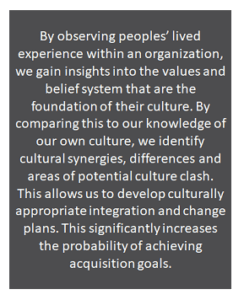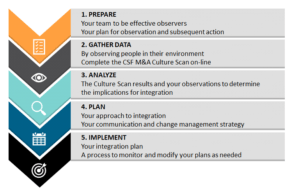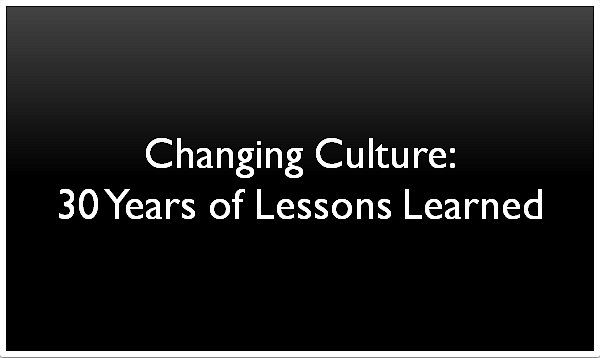Every acquisition an organization makes, no matter how large or small, has a culture that defines the way things are done around here. This is deeply embedded in its DNA and affects all aspects of organizational life. It is anchored in a set of unconscious and taken-for-granted beliefs and assumptions about the expected and best way to behave, interact and work. It is what makes every organization unique and is one of the reasons integrating acquisitions can be a significant challenge.
Even if an acquisition appears to be similar, employees may have different values, beliefs and norms that have implications for integration. For example, the Fire and Security industry typically places a high priority on safety, quality and reliability in order to protect against loss of property and loss of life. The way organizations address this obligation can, however, be very different. One organization may emphasize strict adherence to rules, policies and procedures while others focus on empowering people to use their judgment. Both believe their approach is the right and best way to accomplish their goal. The thing is they are also polar opposites creating the potential for a costly culture clash. If the acquirer were to force the acquisition to adopt its approach, it would immediately be met with resistance. This would be accompanied by a significant risk of employee turnover and a deterioration in performance which could, in a worst-case scenario, lead to loss of property or life and/or erode the value of the acquisition.
Why Is Culture an Important Part of Due Diligence?
Over the past two decades, extensive research has shown that organizations that understand the culture of their acquisitions and use this knowledge to make deal decisions and develop culturally appropriate and effective integration strategies and plans are more likely to be successful than those that don’t. By assessing culture during due diligence and integration planning, organizations can:
- Identify red flags or non-negotiables: In some cases, cultural differences can present major risks that the acquiring organization is not prepared to take. For example, a regulated company with a need for strict adherence to policies would have to carefully consider the benefits of acquiring an organization that is flexible when it comes to following rules.
- Determine the best way to phase integration: One of the biggest risks of integration is to unknowingly damage the source of the acquisition’s value. For example, an acquisition that has built a tightly integrated customer-focused operation would suffer if an acquirer forced a change in CRMs or moved customer facing work to another office.
- Increase retention and engagement of critical people: With few exceptions, one of the keys to a successful acquisition is the ability to retain and engage leaders, experts and others who have knowledge, customer relationships and capabilities that are the foundation of its value. While retention packages certainly help, this is not enough to ensure they will continue to dedicate the same level of energy and attention as they have in the past.
- Lower the cost of integration: The proactive identification and removal of obstacles caused by cultural differences allows integration activities to proceed more quickly and effectively thereby reducing associated costs.
- Identify synergies and best practices: In acquiring an organization, there is always the potential to uncover cultural practices that are sources of value to one or both organizations. For example, identifying the specific practices that allow for the rapid development and release of new products would be of huge value to an acquirer who has been struggling in this area. What Is Involved?
When to Conduct Culture Due Diligence
Including culture as part of due diligence and integration planning is recommended for most acquisitions especially when success depends on the retention and engagement of people. The exception is when the reason for acquiring the organization is to gain access to specific assets and does not involve acquiring people. For example, a company acquires existing customer contracts from a small owner who has a $5M per year contract to perform a service. The owner is ready to retire, and the acquirer has no intention of retaining the acquired company’s employees or equipment. Of course, there may be differences in the scope of the culture due diligence depending on the size of the acquisition. However, if the acquisition involves onboarding one or more people, it is still important to understand their interests, motivations and behavior but this will be a relatively short and simple undertaking.
With this in mind, culture due diligence can be conducted at different points in the acquisition process depending on the objective. Obviously, if culture is a consideration in making a deal decision, it needs to be included in due diligence activities. In most cases, culture isn’t a deciding factor which means its primary purpose is to inform integration plans. The bottom-line is the earlier culture due diligence is completed, the more time there is to develop effective plans. It can however occur after a deal closes, preferably as soon as possible before changes are implemented in the acquired organization. There is also an advantage to post-close due diligence activities as this provides the opportunity to involve people from both organizations in the process. This circumvents the need for observation which is replaced by focused discussions in a workshop format. This is very effective in identifying synergies and cultural tensions while engaging acquired employees in planning activities that can increase buy-in and support for the changes to be implemented.
What Does Culture Due Diligence Involve?
Culture due diligence is conducted by members of the acquiring organization’s due diligence or integration team who directly interact with and have access to the acquisition’s leaders, people and facilities. Observations occur as team members participate in negotiations and/or pre or post-close activities. Why observations versus surveys or other methods? For one, it is rarely possible to survey or engage people in a potential acquisition until after a deal closes. This leaves us with members of the acquiring organization as our source. Before we can ask them to complete a survey about the acquired organization, they need to gain some insights about the way they operate, their beliefs and values. This is where guided observations play a valuable role.
Observation is a method employed to learn about the physical, social, cultural, and economic contexts in which the members of an organization live; the relationships among and between people, contexts, ideas, norms, and events; and people’s behaviors and activities – what they do, how frequently, and with whom. It is unique because the observers interact with people in the organization rather than simply watching from a distance. This provides the opportunity to learn what life is like for an “insider” while remaining, an “outsider.” With these insights, due diligence team members are equipped to compare the cultures of the combining organizations.
The value of a guided approach is it focuses people on the culture attributes with the greatest potential to cause culture clash. It also saves time in gathering and making sense of the data. This is important given the demands placed on due diligence and integration teams. It is also the reason we use a short culture survey to help make sense of the observations. The survey uses the same culture framework as the observation guide. This allows us to easily and quickly identify similarities and differences in the culture and focus discussions on those with the greatest potential to affect integration.
Success Factors
In addition to competing demands and heavy workload, due diligence team members rarely have much in the way of knowledge or experience with culture or observations. This combination of factors is the main reason it is so difficult to get culture included in due diligence activities despite the strong evidence of its value. There are however ways to address this including:
#1 Make It Part of Existing Due Diligence Activities –
For culture due diligence to have any chance, it must be built into existing due diligence and integration planning activities; it cannot be a separate process although some additional time is required. The basic concept is we ask people who are already interfacing with the acquisition to make observations about their culture.
#2 Minimize Workload –
To address the objection of lack of time and too few resources, we focus observations on the culture attributes that have the highest risk of culture clash. We then divide these among the members of the due diligence team. As a result, an individual typically is asked to observe at most two or three different culture attributes. In addition, the two workshops used at the beginning and end of the observation phase are very structured and focused minimizing the time required of due diligence team members. The survey also helps by providing data to guide discussions of the observations and their implications for integration.
#3 Make It Easy –
To address the objection that culture due diligence is outside people’s expertise and comfort zone, we provide a short training session that explains how to conduct effective observations, what to look for and how to make sense of what they see. This is an investment of time but well worth it. We’ve found that attempts to conduct culture due diligence without this fail abysmally. It also helps to provide them with practical examples or clues that focus them on what is important. We’ve tried unguided observation with mixed results. Remember, due diligence team members are doing other work, and this is competing for their time and attention. We must make it easy or it simply won’t happen.
The Discipline of Culture Due Diligence
Culture due diligence requires discipline to be effective. Simply bringing people together to talk about culture doesn’t work, unless they are from both organizations and someone knows enough about culture to focus the discussion. Nor does completing a culture survey; that is, unless you can survey employees in the acquisition. By preparing due diligence teams and providing them with knowledge, support and tools, we can acquire the data and insights needed to make informed decisions. This allows us to create plans that leverage cultural synergies to ease the transition and addresses cultural tensions that could derail integration efforts.
But, how do we connect all the dots to arrive at this outcome? This is where a disciplined approach is important. To this end, we follow the five-step process shown in the following diagram. The process is straightforward. The key is in its implementation.
Phase 2. Gather Data
The culture due diligence team conducts on-site observations as part of their other due diligence activities. We ask them to take notes after their site visit and interactions, so they have these for later reference. They don’t have to be overly detailed; just reminders they can use when it comes time to analyze the results.
When the observations are complete, the next step is to complete a 25-item culture assessment. The assessment, called the M&A Culture Scan, asks the observers to rate the acquisition’s culture using the same framework as the observations. In some cases, they also rate the acquirer’s culture although this is usually established ahead of time. The purpose of the Culture Scan is to focus discussions on the culture attributes with the greatest potential for synergy and culture clash. It is not intended to be conclusive but rather directional. The main benefit is it saves time and provides data that identifies similarities and differences in the perspectives of the observers.
Phase 3. Analyze
Once we have the data, the next step is to make sense of it. This is where we bring the due diligence team together to discuss their observations using the Culture Scan results to prioritize topics. The discussion focuses on potential synergies and tensions and the implications for integration. We augment the discussion with a tool that identifies potential risks and implications plus suggestions for actions to include in integration plans. This is intended as directional rather than prescriptive.
The discussions take place in a workshop format which can be done face-to-face or by webinar. We’ve found the face-to-face format more effective as people are more likely to actively engage in discussions. Unfortunately, this isn’t always possible due to costs and geography. The workshop typically takes about four hours but can be longer depending on the extent of the differences identified. The outcome is a prioritized list of cultural synergies and tensions with recommended actions to be used to inform integration plans. In most organizations, this concludes the engagement of the due diligence team members who hand-off to the integration team.
Phase 4. Planning
This phase takes the outcomes from the analyze phase and uses them to develop or refine integration plans. In most cases, this is led by Human Resources sometimes with the participation of integration team members. This includes developing culturally appropriate communication and change plans leveraging proven change management practices.
It is important to note that this is often where things go wrong. Successful cultural integration sometimes means being willing to delay or not make changes that have been targeted to achieve cost synergies until a transition plan can be put in place. Unfortunately, the pressure to realize the financial benefits of an acquisition often take precedent over doing things right. All we can say is that to avoid the pain of culture clash, you must be willing to make the tough decisions even when they require paying the price in the short-term to realize benefits in the long-term.
Phase 5. Implementation
Culture work is not an exact science. While we can anticipate how the changes made during integration may affect culture, we cannot predict everything. We must constantly monitor the acquisition to identify, as early as possible, unintended negative consequences so they can be addressed.
We recommend a quarterly pulse check focused on the areas identified as a high risk for culture clash, employee engagement and a general scan to identify unexpected developments. If possible, the best approach is to conduct a short pulse survey followed by focus groups or round tables with acquisition employees, if necessary. While an investment, it is far cheaper than dealing with the consequences of a significant culture clash left unaddressed.
In Closing
Culture due diligence is an investment. It takes people, time and money to do it well. This is the main reason it doesn’t happen. People are too busy or there isn’t money in the budget to take on culture as part of due diligence activities. If there is, it only covers up to the analyze phase and there is an unwillingness to make the investment to achieve a successful integration.
Let’s put this in perspective. The investment required to include culture in due diligence and integration activities is a drop in the bucket when compared with the cost of acquiring an organization. It is next to nothing! At the same time, the potential benefits are huge. Consider the evidence citing the number of acquisitions that fail to realize the expected financial and other benefits as a result of, first and foremost, incompatible cultures.
Hopefully, this article has helped to demystify culture due diligence. Yes, it requires knowledge and an investment, but it isn’t rocket science. By applying a simple, disciplined approach backed up by knowledge transfer, any organization can take on culture due diligence and be successful.
© CULTURESTRATEGYFIT
® All rights reserved
Dr. Nancie Evans
Dr. Nancie Evans is co-founder and VP Client Solutions at CultureStrategyFit® Inc. specializing in the alignment of organizational culture and strategy. She has developed a unique set of leading-edge diagnostic tools and approaches that provide leaders with deep insights into the culture of their organizations, how it is supporting or getting in the way of strategy execution, as well as the levers that they can use to drive rapid culture change.
CULTURESTRATEGYFIT®
CultureStrategyFit®
Inc. is a leading culture and executive leadership consulting firm conducting groundbreaking work in leveraging culture to drive strategy and performance. Its suite of culture surveys and culture alignment tools are used by market-leading organizations around the world.












